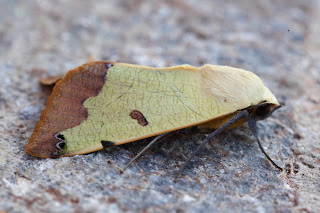Sarah and I took a much needed break on
Crete from 3rd to 9th October, this was not a birding
trip as such mainly a much needed rest from the hectic 2012 bat survey season
and a recent house move. However, me being me I did manage to do a little
birding and in addition I took my actinic moth trap with me. Therefore, this
posting will provide a little information on birds we saw
(albeit not many!) and the moths we recorded.
We stayed in Elounda on the north coast of
the island at the Domes of Elounda resort http://www.domesofelounda.com - while
not the cheapest resort we weren’t after cheap we wanted somewhere nice to stay
with a decent view and potentially with some birding and the resort certainly
provided us with this. The resort is located on a slope running down to the sea
and our room was located at the top of the slope affording good views to
Spinolonga Island http://en.wikipedia.org/wiki/Spinalonga I was able to run my moth trap in our small private garden. This is the view
from our balcony:
Spinalonga Island from Domes of Eulonda
During our stay we explored mainly the central area of the island from Heraklion in the west, to Gourtys in the south and east as far as Gournia.
Moths
To date I have been able to identify a
total of 18 species trapped at Elounda with around another 15 photographed and still to
identify. These included a range of species recorded as migrants to the UK as
well as some unfamiliar species. Those identified to date are: vestal, obscure bar, hummingbird hawk-moth, eastern bordered straw, small mottled willow, pale mottled willow, dark mottled willow, shuttle shaped dart, dark sword grass, Mythimna
ruparia, Opthiusa
tirhaca, Devonshire wainscot, cosmopolitan, golden twin-spot, pale shoulder, purple marbled, Udea
ferigalis, Nomophila
noctuella and Palpita
vitrealis.
Devonshire Wainscot
Pale Shoulder
Palpita vitrealis
Opthiusa tirhaca
Purple Marbled
Golden Twin-spot
Birds
I have to say my experience of birding on
the island was not astounding. We saw very little and not really through lack
of trying (or through to much relaxing by the pool with a glass!). There
appeared to be a lack of migrants on the island at the time of our stay (possibly due to the presence of a long settled high pressure system over the eastern Mediterranean) and relatively few resident
birds. Highlights included: griffon vulture, Eleanora’s falcon, booted eagle, golden eagle, yellow-legged gull, crested lark, red-throated pipit, Sardinian warbler, red-backed shrike, chough, Italian sparrow and cirl bunting. Most of these birds appeared to be generally distributed and we did not visit any specific sites to see these birds. There are no endemic bird species on the island which is a little surprising given its relative isolation especially when considering an island such as Corsica. The races of jay (race cretorum) and great tit (race niethammeri) are endemic.
Griffon vulture
Sardinian warbler
Further Information
If you are considering a birding trip to Crete then the following websites are useful:
For moths I used Volumes 1, 2 and 3 of Patrice Leraut's 'Moths of Europe' published by N.A.P Editions.



.jpg)













